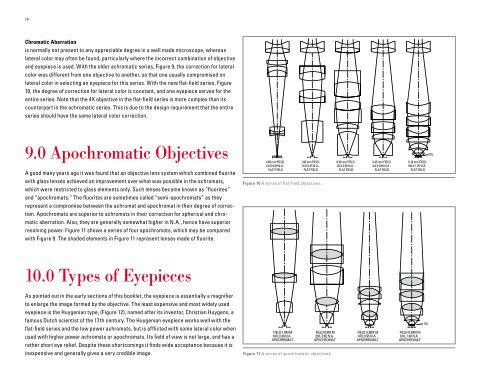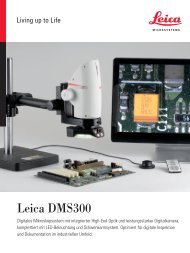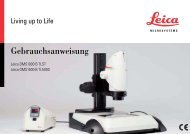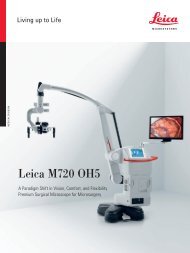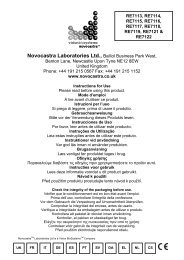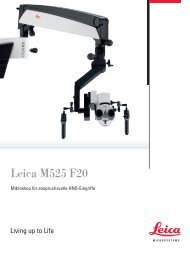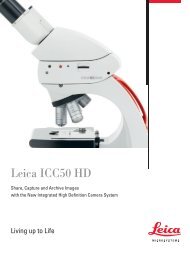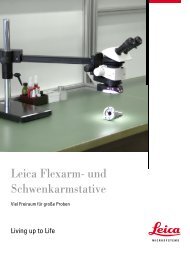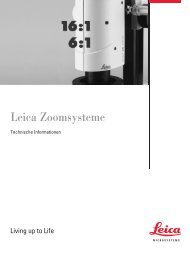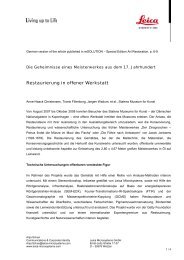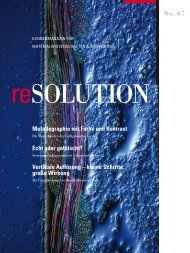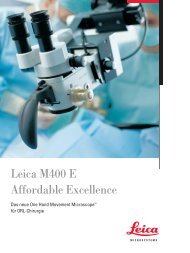The Theory of the Microscope - Leica Microsystems
The Theory of the Microscope - Leica Microsystems
The Theory of the Microscope - Leica Microsystems
Create successful ePaper yourself
Turn your PDF publications into a flip-book with our unique Google optimized e-Paper software.
10<br />
Chromatic Aberration<br />
is normally not present to any appreciable degree in a well made microscope, whereas<br />
lateral color may <strong>of</strong>ten be found, particularly where <strong>the</strong> incorrect combination <strong>of</strong> objective<br />
and eyepiece is used. With <strong>the</strong> older achromatic series, Figure 9, <strong>the</strong> correction for lateral<br />
color was different from one objective to ano<strong>the</strong>r, so that one usually compromised on<br />
lateral color in selecting an eyepiece for this series. With <strong>the</strong> new flat-field series, Figure<br />
10, <strong>the</strong> degree <strong>of</strong> correction for lateral color is constant, and one eyepiece serves for <strong>the</strong><br />
entire series. Note that <strong>the</strong> 4X objective in <strong>the</strong> flat-field series is more complex than its<br />
counterpart in <strong>the</strong> achromatic series. This is due to <strong>the</strong> design requirement that <strong>the</strong> entire<br />
series should have <strong>the</strong> same lateral color correction.<br />
9.0 Apochromatic Objectives<br />
A good many years ago it was found that an objective lens system which combined fluorite<br />
with glass lenses achieved an improvement over what was possible in <strong>the</strong> achromats,<br />
which were restricted to glass elements only. Such lenses became known as “fluorites”<br />
and “apochromats.” <strong>The</strong> fluorites are sometimes called “semi-apochromats” as <strong>the</strong>y<br />
represent a compromise between <strong>the</strong> achromat and apochromat in <strong>the</strong>ir degree <strong>of</strong> correction.<br />
Apochromats are superior to achromats in <strong>the</strong>ir correction for spherical and chromatic<br />
aberration. Also, <strong>the</strong>y are generally somewhat higher in N.A., hence have superior<br />
resolving power. Figure 11 shows a series <strong>of</strong> four apochromats, which may be compared<br />
with Figure 9. <strong>The</strong> shaded elements in Figure 11 represent lenses made <strong>of</strong> fluorite.<br />
10.0 Types <strong>of</strong> Eyepieces<br />
As pointed out in <strong>the</strong> early sections <strong>of</strong> this booklet, <strong>the</strong> eyepiece is essentially a magnifier<br />
to enlarge <strong>the</strong> image formed by <strong>the</strong> objective. <strong>The</strong> least expensive and most widely used<br />
eyepiece is <strong>the</strong> Huygenian type, (Figure 12), named after its inventor, Christian Huygens, a<br />
famous Dutch scientist <strong>of</strong> <strong>the</strong> 17th century. <strong>The</strong> huygenian eyepiece works well with <strong>the</strong><br />
flat-field series and <strong>the</strong> low power achromats, but is afflicted with some lateral color when<br />
used with higher power achromats or apochromats. Its field <strong>of</strong> view is not large, and has a<br />
ra<strong>the</strong>r short eye relief. Despite <strong>the</strong>se shortcomings it finds wide acceptance because it is<br />
inexpensive and generally gives a very credible image.<br />
4.50 mm FIELD<br />
4.0 X 0.09 N.A .<br />
FLAT FIELD<br />
1.80 mm FIELD<br />
10 X 0.25 N.A .<br />
FLAT FIELD<br />
Figure 10 A series <strong>of</strong> flat-field objectives.<br />
FIELD 1.8MM<br />
10X, 0.30 N.A .<br />
APOCHROMAT<br />
FIELD 0.9M M<br />
20X, 0.65 N.A .<br />
APOCHROMAT<br />
Figure 11 A series <strong>of</strong> apochromatic objectives.<br />
0.90 mm FIELD<br />
20 X 0.50 N.A .<br />
FLAT FIELD<br />
FIELD 0.38M M<br />
47X, 0.95 N.A .<br />
APOCHROMAT<br />
0.45 mm FIELD<br />
4.0 X 0.65 N.A .<br />
FLAT FIELD<br />
0.18 mm FIELD<br />
100 X 1.25 N.A .<br />
FLAT FIELD<br />
FIELD 0.30M M<br />
61X, 1.40 N.A .<br />
APOCHROMAT<br />
OIL<br />
OIL


